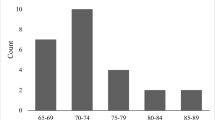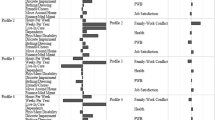Abstract
Volunteers (n = 52) and eldercare employees (n = 160) completed measures of personal motives, sense of community, and satisfaction and stress from assisting the elderly. Caregiver satisfaction was best predicted for volunteers by feelings of reciprocal responsibility to peers. For employees, satisfaction was predicted by strong motives reflecting one’s personal values, heightening self-esteem, gaining an understanding of the elderly, and a need to socialize with others. Caregiver stress for volunteers was predicted by motives of low self-esteem, high needs for protection from similar illness, and a desire toward enhancing one’s personal career goals. For employees, stress was predicted by low levels of reciprocal responsibility and a desire for protection. Results suggest that eldercare satisfaction and stress are predicted by different variables for volunteer and employees requiring different program development for recruitment and retention. Editors’ Strategic Implications: The findings have implications for the way elder care administrators prevent worker and volunteer turnover and thus promote client welfare. Measures of personal motivation and community connection may be relevant to other prevention settings as well.
Similar content being viewed by others
References
Bishop, P. D., Chertok, F., & Jason, L. A. (1997). Measuring sense of community: Beyond local boundaries. Journal of Primary Prevention, 18, 193–212.
Bishop, P. D., Jason, L. A., Ferrari, J. R., & Cheng-Fang, H. (1998). A survival analysis of communal-living, self-help, addiction recovery participants. American Journal of Community Psychology, 26, 803–821.
Bowman, H. W., & Ferrari, J. R. (2003). In the service of others: Functions, management, and recruitment of volunteers at Southern Cross Care of Tasmania. Technical report submitted to SCC (Tas), Tasmania, Australia.
Brannon, D., Zinn, J. S., Mor, V., & Davis, J. (2002). An exploration of job, organizational, environmental factors associated with high and low nursing assistant turnover. Gerontologist, 42, 159–168.
Bristow, M. J., & Ferrari, J. R. (2005). Employee status, satisfaction, and stress: Examining a sense of community and caregiver experience among Australian eldercare staff. Networks: Australian Community Psychology Journal, 17, 16–22.
Burroughs, S. M., & Eby, L. T. (1998). Psychological sense of community at work: A measurement and explanatory framework. Journal of Community Psychology, 26, 509–532.
Catano, V. M., Pretty, G. M., Southwell, R. R., & Cole, G. K. (1993). Sense of community and union participation. Psychological Reports, 72, 333–334.
Choi, L. H. (2003). Factors affecting volunteerism among older adults. Journal of Applied Gerontology, 22, 179–196.
Clary, E. G., Snyder, M., & Ridge, R. (1992). Volunteers’ motivations: A functional strategy for the recruitment, placement, and retention of volunteers. Non-Profit Management and Leadership, 2, 349–354.
Clary, E. G., Snyder, M., Ridge, R. D., Copeland, J., Stukas, A. A., Haugen, J., et al. (1998). Understanding and assessing the motivations of volunteers: A functional approach. Journal of Personality and Social Psychology, 74, 1516–1530.
Clipp, E. C., & George, L. K. (1990). Caregiver needs and patterns of social support. Journal of Gerontology, 45, S102–S111.
Cohen, B. H. (2001). Explaining psychological statistics (2nd ed.). New York: John Wiley & Sons, Inc.
Curtis, M. P., Sales, A. E. B., Sullivan, J. H., Gray, S. L., & Hedrick, S. C. (2005). Satisfaction with care among community residential care residents. Journal of Aging and Health, 17, 3–27.
Ferrari, J. R. (2004). Comparing volunteers and temporary eldercare workers on community care perceptions. Evaluation and the Health Professions, 27, 383–397.
Ferrari, J. R., Kapoor, M., Bristow, M., & Bowman, W. H. (2006). Community elder-care in Tasmania: Examining whether caregivers believe they “make-a-difference” in an urban and rural island. Journal of Prevention and Intervention in the Community, 32, 115–131.
Ferrari, J. R., Loftus, M. M., & Pesek, J. (1999). Young and older caregivers at homeless animal and human shelters: Selfish and selfless motives in helping others. Journal of Social Distress & the Homeless, 8, 37–49.
Ferrari, J. R., McCrown, W., & Pantano, J. (1993). Experiencing satisfaction and stress as an AIDS care provider: “The AIDS caregiver” scale. Evaluation and the Health Professions, 16, 295–310.
Gilley, D. W., McCann, J. J., Bienias, J. L., & Evans, D. A. (2005). Caregiver psychological adjustment and institutionalization of persons with Alzheimer’s disease. Journal of Aging and Health, 17, 172–189.
Grube, J. A., & Piliavin, J. A. (2000). Role identity, organizational experiences, and volunteer performance. Personality and Social Psychology Bulletin, 26, 1108–1119.
Hollinger-Smith, L. (2003). It takes a village to retain quality nursing staff. Nursing Homes Long Term Care Management, 52, 52–56.
Hunter, A., & Riger, S. (1986). The meaning of community in community mental health. Journal of Community Psychology, 14, 55–71.
Kapoor, M., & Ferrari, J. R. (2005). Psychological sense of community among eldercare volunteers: Understanding caregivers in Tasmania. Australian Journal of Volunteering, 10, 7–14.
Lambert, S. J. (1990). Processes linking work and family: A critical review and research agenda. Human Relations, 43, 239–257.
Lambert, S. J. (2000). Added benefits: The link between work-life benefits and organizational citizenship behavior. Academy of Management Journal, 43, 801–815.
Lowenthal, M., & Haven, C. (1968). Interaction and adaptation: Intimacy as a critical variable. American Sociological Review, 33, 20–30.
Neufeld, A., & Harrison, M. J. (1995). Reciprocity and social support in caregivers’ relationships: Variations and consequences. Qualitative Health Research, 5, 348–365.
Okun, M. A., & Michel, J. (2006). Sense of community and being a volunteer among the young-old. Journal of Applied Gerontology, 25, 173–188.
Omoto, A. M., & Malsch, A. M. (2005). Psychological sense of community: Conceptual issues and connections to volunteerism-related activism. In A. M. Omoto (Ed.), Processes of community change and social action (pp. 83–103). Mahwah, NJ: Lawrence Erlbaum Associates, Publishers.
Omoto, A. M., & Snyder, M. (1995). Sustained helping without obligation: Motivation, longevity of service, and perceived attitude change among AIDS volunteers. Journal of Personality and Social Psychology, 68, 671–686.
Omoto, A. M., & Snyder, M. (2002). Considerations of community: The context and process of volunteerism. American Behavioral Scientist, 45, 846–867.
Omoto, A. M., Snyder, M., & Martino, S. C. (2000). Volunteerism and the life course: Investigating age-related agendas for action. Basic and Applied Social Psychology, 22, 181–197.
Reynolds, W. M. (1982). Development of reliable and valid short forms of the Marlow-Crowne social desirability scale. Journal of Clinical Psychology, 38, 119–125.
Sanchez, B., & Ferrari, J. R. (2005). Mentoring relationships of eldercare staff in Australia: Influence on service motives, sense of community, and caregiver experiences. Journal of Community Psychology, 33, 245–252.
Sherwood, P. R., Given, C. W., Given, B. A., & von Eye, A. (2005). Caregiver burden and depressive symptoms. Journal of Aging and Health, 17, 125–147.
Snyder, M., & Omoto, A. M. (2001). Basic research and practical problems: Volunteerism and the psychology of individual and collective action. In W. Wosinska, R. B. Cialdini, D. W. Barrett, & J. Reykowski (Eds.), The practice of social influence in multiple cultures (pp. 287–307). Mahwah, NJ: Lawrence Erlbaum Associates, Publishers.
Sorensen, S., Pinquart, M., & Duberstein, P. (2002). How effective are interventions with caregivers? An updated meta-analysis. Gerontologist, 42, 356–372.
Swisher, J. D., Scherer, J., & Yin, R. K. (2004). Cost-benefit estimates in prevention research. Journal of Primary Prevention, 25, 137–148.
Tilden, V. P., & Gaylen, R. D. (1987). Cost and conflict: The darker side of social support. Western Journal of Nursing Research, 9, 9–18.
Yberma, J. F., Kuijer, R. G., Hagedoorn, M., & Buunk, B. P. (2002). Caregiver burnout among intimate partners of patients with a severe illness: An equity perspective. Personal Relationships, 9, 73–88.
Zainuddin, J., & Arokiasamy, J. T. (2003). Caregiving burden is associated with short rather than long duration of care for older persons. Asia-Pacific Journal of Public Health, 15, 88–93.
Acknowledgments
This project was funded in part by a DePaul “Competitive Research Council” Award, with ground transportation and supplies by Southern Cross Care, Inc. (Tas), and housing by the University of Tasmania “Visiting Scholar Program” provided to the second author in support of a research leave. Gratitude is expressed to Richard Sadek, Peter Patmore, the Board of Trustees, and staff and volunteers at SCC (Tas). Special thanks is expressed to Garry Askey-Doran, who facilitated this project, assisted in the data collection process, and provided guidance, support, and above all friendship, making this project possible and a pleasure.
Author information
Authors and Affiliations
Corresponding author
Rights and permissions
About this article
Cite this article
Ferrari, J.R., Luhrs, T. & Lyman, V. Eldercare Volunteers and Employees: Predicting Caregiver Experiences from Service Motives and Sense of Community. J Primary Prevent 28, 467–479 (2007). https://doi.org/10.1007/s10935-007-0108-6
Received:
Accepted:
Published:
Issue Date:
DOI: https://doi.org/10.1007/s10935-007-0108-6




